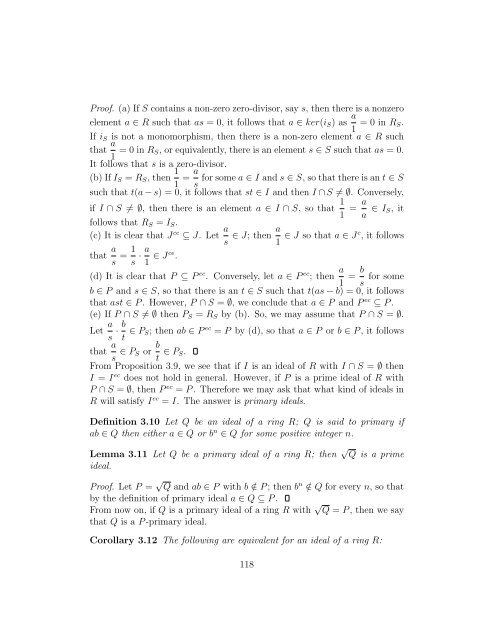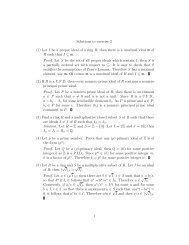Topics in algebra Chapter IV: Commutative rings and modules I - 1
Topics in algebra Chapter IV: Commutative rings and modules I - 1
Topics in algebra Chapter IV: Commutative rings and modules I - 1
You also want an ePaper? Increase the reach of your titles
YUMPU automatically turns print PDFs into web optimized ePapers that Google loves.
Proof. (a) If S conta<strong>in</strong>s a non-zero zero-divisor, say s, then there is a nonzero<br />
element a ∈ R such that as = 0, it follows that a ∈ ker(iS) as a<br />
= 0 <strong>in</strong> RS.<br />
1<br />
If iS is not a monomorphism, then there is a non-zero element a ∈ R such<br />
that a<br />
1 = 0 <strong>in</strong> RS, or equivalently, there is an element s ∈ S such that as = 0.<br />
It follows that s is a zero-divisor.<br />
(b) If IS = RS, then 1 a<br />
= for some a ∈ I <strong>and</strong> s ∈ S, so that there is an t ∈ S<br />
1 s<br />
such that t(a − s) = 0, it follows that st ∈ I <strong>and</strong> then I ∩ S = ∅. Conversely,<br />
if I ∩ S = ∅, then there is an element a ∈ I ∩ S, so that 1 a<br />
=<br />
1 a ∈ IS, it<br />
follows that RS = IS.<br />
(c) It is clear that J ce ⊆ J. Let a a<br />
∈ J; then<br />
s 1 ∈ J so that a ∈ J c , it follows<br />
that a 1 a<br />
= ·<br />
s s 1 ∈ J ce .<br />
(d) It is clear that P ⊆ P ec . Conversely, let a ∈ P ec ; then a b<br />
= for some<br />
1 s<br />
b ∈ P <strong>and</strong> s ∈ S, so that there is an t ∈ S such that t(as − b) = 0, it follows<br />
that ast ∈ P . However, P ∩ S = ∅, we conclude that a ∈ P <strong>and</strong> P ec ⊆ P .<br />
(e) If P ∩ S = ∅ then PS = RS by (b). So, we may assume that P ∩ S = ∅.<br />
Let a b<br />
·<br />
s t ∈ PS; then ab ∈ P ec = P by (d), so that a ∈ P or b ∈ P , it follows<br />
that a<br />
s ∈ PS or b<br />
∈ PS.<br />
t<br />
From Proposition 3.9, we see that if I is an ideal of R with I ∩ S = ∅ then<br />
I = I ec does not hold <strong>in</strong> general. However, if P is a prime ideal of R with<br />
P ∩ S = ∅, then P ec = P . Therefore we may ask that what k<strong>in</strong>d of ideals <strong>in</strong><br />
R will satisfy I ec = I. The answer is primary ideals.<br />
Def<strong>in</strong>ition 3.10 Let Q be an ideal of a r<strong>in</strong>g R; Q is said to primary if<br />
ab ∈ Q then either a ∈ Q or b n ∈ Q for some positive <strong>in</strong>teger n.<br />
Lemma 3.11 Let Q be a primary ideal of a r<strong>in</strong>g R; then √ Q is a prime<br />
ideal.<br />
Proof. Let P = √ Q <strong>and</strong> ab ∈ P with b /∈ P ; then b n /∈ Q for every n, so that<br />
by the def<strong>in</strong>ition of primary ideal a ∈ Q ⊆ P .<br />
From now on, if Q is a primary ideal of a r<strong>in</strong>g R with √ Q = P , then we say<br />
that Q is a P -primary ideal.<br />
Corollary 3.12 The follow<strong>in</strong>g are equivalent for an ideal of a r<strong>in</strong>g R:<br />
118



